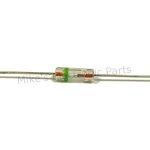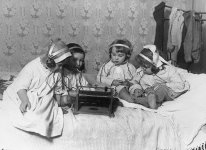OA79 diode across a telephone speaker, with a long antenna.
That is a glass diode with a whisker, used for recievers.
No power, and we lived near the transmitter in Jaipur.
Probably still in my storage.
That is a glass diode with a whisker, used for recievers.
No power, and we lived near the transmitter in Jaipur.
Probably still in my storage.
OA79 diode
The 1N34A germanium diode is very popular with crystal radio set builders because of its low forward voltage drop, which means you only need a small signal voltage to begin to hear radio stations. https://www.mikeselectronicparts.com/product/1n34a/
Attachments
My first properly "electronics" project was a crystal set.Anyone else had a crystal set?
I STILL keep somewhere the (broken) ferrite stick.
I was born in an agricultural town in the middle of the Pampas, and way back then Citizen Radio (still all tube sets) was popular to connect "estancias"(cattle farms) with owners living in "the city".
By sheer chance, I guess resonance with self capacitance, my AM band ferrite stick got tuned at some Citizens band channel when I accidentally removed tuning capacitor, so I could hear their traffic.
Typically "the tractor broke down", " a cow is sick", etc. but now and then I heard "hey Boss, glad you are coming today, we just killed a cow/pig and we are grilling it on a charcoal pit" or "my wife made some of her famous Lasagna", etc.
So I went to visit my friend, who´d say "pity, I´m about to go to the farm .... wanna come?"
" weeeelllll, if you INSIST " 😉
Who says Short Wave Listening has no practical uses? 😉
Built my first crystal set at age 12. My uncle, who was a talented cabinet maker, also gave me his beautiful cat's whisker receiver. The magic of AM radio is gone, but it gave me an eternal love of electronics.
I got the mumps when I was ~ 8 years old, mid 1950's ~ to keep me amused my folks got me a Remco crystal radio kit. The next spring I found a carbon microphone and a speaker and wired them up with some D-cells.
Through the years with 3 sons and 9 grand-children, I find that they are happier with the box the toy came with, than the toy itself. On a rainy vacation day, they are doing what we did with scotch tape, glue paste and scissors with those cardboard boxes. If only all little kids could experience the same.
Through the years with 3 sons and 9 grand-children, I find that they are happier with the box the toy came with, than the toy itself. On a rainy vacation day, they are doing what we did with scotch tape, glue paste and scissors with those cardboard boxes. If only all little kids could experience the same.
My parents gave me a portable AM radio when I was about 10. I found a connection that made it into a variable oscillator.
And the game was a foot......
And the game was a foot......
OA1160 germanium "needle electrode, glass tube case" diode here. It is still in production and available after 60+ years!The 1N34A germanium diode is very popular with crystal radio set builders because of its low forward voltage drop, which means you only need a small signal voltage to begin to hear radio stations. https://www.mikeselectronicparts.com/product/1n34a/
Germanium diodes are still in production because they have a few niche but irreplaceable uses.
No, Schottky diodes can NOT replace them as signal detectors.
No, Schottky diodes can NOT replace them as signal detectors.
Not as a direct replacement, no. But a circuit can be designed to use a schottky as a detector. Some applications with a high enough signal level could afford to use one as a replacement. Typical crystal Set is not one of them.
I've met people who use an auxillary battery and a 25 turn trimmer pot, to DC offset one or the other terminals of the detector diode. This lets them operate the detector at a different point on its voltage-current characteristic. It also lets them experiment with a variety of different diode types, including the gate-drain diode of femtoammeter JFETs like 2N4117.
What, you didn't have the Knight Kit AM Broadcaster? Two 50C5's and a 12AX7 -- I had one in 6th grade.My parents gave me a portable AM radio when I was about 10. I found a connection that made it into a variable oscillator.
And the game was a foot......
I remember kids building little transmitters. Like the Dutch kid with the petrol powered bicycle, they eventually came to grief.
I bought and built the Radio Shack FM transmitter kit. It worked but twelve year old me was disappointed that it required the builder to futz around with the turn-to-turn spacing of the hand wound coil, to tune the frequency. I guess I thought that Radio Shack was a huge company with infinite resources, and surely they could provide a kit which worked perfectly as soon as the final joint was soldered. With no adjustments.
I had not yet internalized the proverb of the dancing bear.
"The marvel is not that the bear dances well, but that he dances at all"
I had not yet internalized the proverb of the dancing bear.
"The marvel is not that the bear dances well, but that he dances at all"
I remember kids building little transmitters.
Here's a cute quartet of budding radio technicians:
Attachments
You needed a Collins Permeability Tuned Oscillator! https://www.collinsradio.org/pto-overview-specifications-history/It worked but twelve year old me was disappointed that it required the builder to futz around with the turn-to-turn spacing of the hand wound coil, to tune the frequency.
One of the DIYAUDIO correspondents from Argentina has built a PTO for broadcast FM.
I beg to differ, but I guess some are not even that lucky....But once a knight is enough for any man!
Attachments
- Home
- Member Areas
- The Lounge
- Something to lighten the mood


